
Fredericksburg
WILLKOMMEN! Of all the interesting things about Fredericksburg, the one I find most noteworthy is an 1847 treaty between the Comanche Indians and John O. Meusebach (1812-1897), leader of the Fredericksburg settlers. How old was Mr. Meusebach when the treaty was signed? This treaty was NEVER broken. Most agreements between the white man and the Indian were altered when white men wanted more of whatever the Indians had. John Meusebach gave his word and kept it. 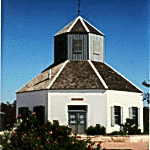
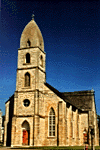 In other places we've visited, we have noted the importance of the church
to the community. The octagonal structure you see on the left is known
as Vereins Kirche or the "coffee mill" ("Die Kaffee-Muehle"). How many
sides does an octagon have? It was the first public building in Fredericksburg
and served as a church, school, or meeting hall depending on the need.
All church denominations used this building until they could construct
a church of their own. It is also the place where residents sought protection
from Indian attacks. The building on the right is Marien Kirche or Saint
Mary's church and was built in 1863. If you had to guess, what do you
think "kirche" means in German?
In other places we've visited, we have noted the importance of the church
to the community. The octagonal structure you see on the left is known
as Vereins Kirche or the "coffee mill" ("Die Kaffee-Muehle"). How many
sides does an octagon have? It was the first public building in Fredericksburg
and served as a church, school, or meeting hall depending on the need.
All church denominations used this building until they could construct
a church of their own. It is also the place where residents sought protection
from Indian attacks. The building on the right is Marien Kirche or Saint
Mary's church and was built in 1863. If you had to guess, what do you
think "kirche" means in German?
 This
arbor leads to St.Barnabas Episcopal church where former President Lyndon
B. Johnson and his family attended church. The mission church was started
in the home of Peter Walter. The Walter house, built in 1847, (second
from the left in the houses pictured below) still sits on the church grounds.
This
arbor leads to St.Barnabas Episcopal church where former President Lyndon
B. Johnson and his family attended church. The mission church was started
in the home of Peter Walter. The Walter house, built in 1847, (second
from the left in the houses pictured below) still sits on the church grounds.
Providing shelter was always one of the first concerns addressed by settlers. Early homes were simple shelters made from whatever brush could be gathered. Log cabins took more time to build (picture on left) Then came the fachwerk houses (next two pictures) What is meant by "fachwerk"? The size and weight of native limestone blocks caused buildings and houses made of limestone to take considerable time and effort to construct (pictures four and five) Availability of milled lumber changed the appearance of the houses yet again (last picture).
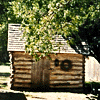
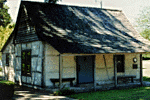
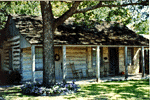
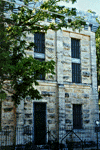
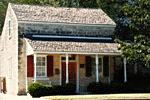
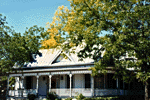
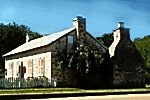 The
furniture maker, Peter Tatsch, owned this limestone block house. Notice
the rear fireplace which is large enough to roast an entire cow. Some
of us have trouble getting a holiday turkey in our ovens. Imagine trying
to roast a whole cow at one time.
The
furniture maker, Peter Tatsch, owned this limestone block house. Notice
the rear fireplace which is large enough to roast an entire cow. Some
of us have trouble getting a holiday turkey in our ovens. Imagine trying
to roast a whole cow at one time.
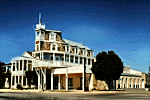
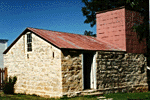 Before 1870, there were no hotels between Fredericksburg and San Diego,
California. The Nimitz Hotel was your last chance to be assured a clean
bed and good food before heading west. It was built in 1847 by the grandfather
of Admiral
Chester W. Nimitz (World War II) with only four rooms and a fireplace.
Over the years it grew to forty-five rooms and began to look like a steamboat.
The stone structure on the right was the bath house with a cistern on
top for collecting rain water. Large iron kettles were used to heat the
water for the tin bath tubs. It wasn't very private, but you could get
cleaner than using a pitcher and basin in your room.
Before 1870, there were no hotels between Fredericksburg and San Diego,
California. The Nimitz Hotel was your last chance to be assured a clean
bed and good food before heading west. It was built in 1847 by the grandfather
of Admiral
Chester W. Nimitz (World War II) with only four rooms and a fireplace.
Over the years it grew to forty-five rooms and began to look like a steamboat.
The stone structure on the right was the bath house with a cistern on
top for collecting rain water. Large iron kettles were used to heat the
water for the tin bath tubs. It wasn't very private, but you could get
cleaner than using a pitcher and basin in your room.
Near the churches in Fredericksburg, you'll find small houses which were only used on weekends. Notice the size of the house in the second picture compared to the size of the live oak tree. They became known as Sunday houses. Families would come to town on Saturday to do their shopping and stay overnight in their one-room-with-a-sleeping-loft Sunday house so they could attend church the next day before returning home.
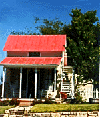
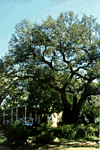
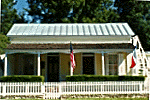
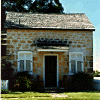 Not all small houses were Sunday houses.
Not all small houses were Sunday houses.

Books to Read and Other Resources
- TWENTY TEXANS HISTORIC LIVES FOR YOUNG READERS by Betsy Warren; Hendrick-Long Publishing Co., 1985
- A PARADISE CALLED TEXAS by Janice Jordan Shefelman; Eakin Press, 1983
- WILLOW CREEK HOME by Janice Jordan Shefelman; Eakin Press, 1985
- SPIRIT OF IRON by Janice Jordan Shefelman; Eakin Press, 1985
- IMMIGRANT
KIDS by Russell Freedman; Scholastic, 1980
The Comanche Indians and Texas
Native American Tribes:Index Pages
Suggested Activity
Research and then construct a model of a Native American dwelling.- Who would have used it?
- What materials were used?
- Where was it found?
- Was it portable? Why or why not?
- How was it constructed without power tools or nails?

For more information, write to:
106 N. Adams Street
P.O.Box 506
Fredericksburg, TX 78624-0506
